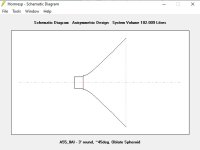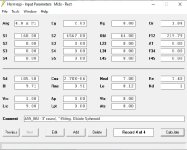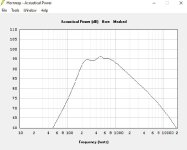@Bigun
Just cover the horn with some damping tissue.
And use on the backside one ore more indirect reflecting tweeters. Take care they fall off sharply below 5khz and the indirect reflecting tweeter(s) should have directivity not to interfere with the sound on axis. Small cones do this
Just cover the horn with some damping tissue.
And use on the backside one ore more indirect reflecting tweeters. Take care they fall off sharply below 5khz and the indirect reflecting tweeter(s) should have directivity not to interfere with the sound on axis. Small cones do this
SPL measurement A / B comparison with / without waveguide with the KEF SP1715, here

massive influence of the waveguide for the tweeter of the coax chassis
second plot with better suited test baffle

very smooth response without the waveguide - bad breakups with the waveguide for the coax tweeter
massive influence of the waveguide for the tweeter of the coax chassis
second plot with better suited test baffle
very smooth response without the waveguide - bad breakups with the waveguide for the coax tweeter
Last edited:
Member
Joined 2009
Paid Member
Thx for the link - Those guys sure do make some pretty looking horns but I can't shake the desire to DIY itHi @Bigun,
i am not such a good carpenter
look here for details
https://www.lautsprechermanufaktur-heyder.de/en-us/lmh-horns/strak-horns
Member
Joined 2009
Paid Member
Thx for this information. I do remember seeing something like this. Unfortunately, I don't have a suitable corner. In my house, there are only two corners suitable for corner horns and they are in my basement. Those spots are already occupied by DIY Vitavox corner horns@Bigun - Also look at vintage designs like Voigt's cornerhorn . I think the magic lies in front and backloading together . The corner horn also relies on the driver pointing at the middle of the ceiling . Look at some forums with Voigt/Lowther fanatics , like hifihaven .
https://www.diyaudio.com/community/threads/the-legendary-k-horn-using-altec-511b-and-808-8a.383814/
My interest in a front-loaded horn using a driver with a whizzer cone will need to be free-standing - well, it can be placed near a room-wall boundary and even towards a corner area. My plan is to use a separate mid-bass horn for the lower decade. So my front loaded whizzer augmented horn is wanted for the range 300Hz or 500Hz up as far as it can go.
Member
Joined 2009
Paid Member
fred, dave,Some interesting bits here https://www.parow.no/lowther/bigfun/
I am not considering a back loaded horn for the simple reasons that
a) the small Lowther "can't do bass" is a position I've adopted whether or not others may have found it suitable I don't expect it to be suitable and don't want to invest time and effort to push the little cone below 300Hz or 500Hz. In terms of keeping this thread generic I think it's partly true for most whizzered full range drivers of less than 6" that bass is best left to a supporting woofer.
b) these full range drivers, and my Lowther included, usually have a rising response. Some kind of horn loading of the front is needed to even out the frequency response. There are some whizzered full range drivers (the Lowther one is popular with Nelson and needs the silver voice coil) which don't need a front horn but many do.
That leaves a compound horn but the question about horn loading a whizzered driver still needs to be addressed for a compound horn.
Member
Joined 2009
Paid Member
I'm not very knowledgeable about interpreting this data, what it seems to suggest is that a waveguide is not helping the situation with the highs, with or without a whizzerfirst SPL quick shot windowed measurement in the room with 37 cm microphone distance on axis
Yes, Dave, then it is backloaded horn just that it is done with the spehrical one  . But the midbass travels differently as in the folded design and also there is some OB character to the sound, although quite a big OB.
. But the midbass travels differently as in the folded design and also there is some OB character to the sound, although quite a big OB.
And I think the wheezer on the driver is already one horn to much )
)
regards
tine
And I think the wheezer on the driver is already one horn to much
regards
tine
Hi @Bigun,
i was surprised to see what the waveguide is doing with the coax chassis, even worse than with the full range chassis with the whizzer cone
i think a full range chassis with a whizzer cone has breakups in the high range anyway
the Sonido SFR200A may be one of the full range chassis that take more advantage as disadvantage from the front mounted waveguide where the front horn acoustic load is taming quite a bit the 330 Hz - 440 Hz resonance coming from the totally undamped cloth surround
the KEF coax with the right crossover between woofer and coaxial mounted tweeter has a smooth frequency response with no breakups, here the waveguide is more a disadvantage
i think the ultima ratio would be to build the front wave guide and judge with listening tests
if you check the gallery of the Sonido DIY folks, there are a lot using front loaded horns as waveguides with the Sonido full range chassis
https://sonido.hu/galeria.php?lang=en#
hope it helps, Stefano
P.S.: just one example of many taken from the Sonido gallery here

i was surprised to see what the waveguide is doing with the coax chassis, even worse than with the full range chassis with the whizzer cone
i think a full range chassis with a whizzer cone has breakups in the high range anyway
the Sonido SFR200A may be one of the full range chassis that take more advantage as disadvantage from the front mounted waveguide where the front horn acoustic load is taming quite a bit the 330 Hz - 440 Hz resonance coming from the totally undamped cloth surround
the KEF coax with the right crossover between woofer and coaxial mounted tweeter has a smooth frequency response with no breakups, here the waveguide is more a disadvantage
i think the ultima ratio would be to build the front wave guide and judge with listening tests
if you check the gallery of the Sonido DIY folks, there are a lot using front loaded horns as waveguides with the Sonido full range chassis
https://sonido.hu/galeria.php?lang=en#
hope it helps, Stefano
P.S.: just one example of many taken from the Sonido gallery here
Last edited:
Member
Joined 2009
Paid Member
Hi Stefano,
This seems like a sensible conclusion.
For a waveguide, I don't pretend to understand the difference between a waveguide and a horn, but ignoring the problems of names, I also don't know which profile would be most suitable. It does have to be relatively shallow with a quickly expanding profile to leave the whizzer cone unhindered. This seems to rule out the exponential/tractrix profiles. And that leaves mostly conical profiles which as I read about have the disadvantage of poorly loading the main cone at low frequencies.
The solution that is recommended from some authors is the Oblate Spheroid coordinate system based profile. As I understand it, this profile is mostly conical but uses a slower throat expansion for better loading and the mouth is curved for less mouth reflections. Do you think this is the right direction ?
I'll take a look at this with Hornresp.
I don't know what profile the front horn you tested has.
This seems like a sensible conclusion.
For a waveguide, I don't pretend to understand the difference between a waveguide and a horn, but ignoring the problems of names, I also don't know which profile would be most suitable. It does have to be relatively shallow with a quickly expanding profile to leave the whizzer cone unhindered. This seems to rule out the exponential/tractrix profiles. And that leaves mostly conical profiles which as I read about have the disadvantage of poorly loading the main cone at low frequencies.
The solution that is recommended from some authors is the Oblate Spheroid coordinate system based profile. As I understand it, this profile is mostly conical but uses a slower throat expansion for better loading and the mouth is curved for less mouth reflections. Do you think this is the right direction ?
I'll take a look at this with Hornresp.
I don't know what profile the front horn you tested has.
Last edited:
Hi @Bigun,
LMH horns and waveguides has the tractrix profile
there is a download link available for the calculator they are using
https://volvotreter.de/downloads/tractrix_v1.3a.xls.zip
the Volvotreter home page is nice to check for horn fans anyway
LMH horns and waveguides has the tractrix profile
there is a download link available for the calculator they are using
https://volvotreter.de/downloads/tractrix_v1.3a.xls.zip
the Volvotreter home page is nice to check for horn fans anyway
You design it based on its effective acoustic diameter, which is enough larger to loosely fit over it, i.e. only WG loaded, so no small throats, extra long horns unless tuned extremely low over a very wide BW.GM - Interesting - I've never seen a separate horn insert before, neither spoken of or written and I don't see how it would even work with a whizzer because that part of the driver could not be sealed to the throat
Well, you fellas have confirmed my concerns that most front horns are not designed to account for drivers with whizzer cones. They are usually too long/deep, i.e. designed to maximize low frequency gain and as a result the whizzer would radiate into the walls of the horn. Even if that were not enough of an issue, these deep horns with small throats beam of their own accord and really deserve to have a separate tweeter.
Yes and no since any whizzer cone driver that has a stepped whizzer BW is one whether specifically designed for horn loading or not.
1) The main horn is WAY too large compared to whizzer cone size, so the latter will be radiating into free space.
Or consider the horn part of the room , not any device loading the whizzer cone.
2) besides, they are horribly coupled.
You would need a phase plug or compression chamber to improve that.
Or consider the horn part of the room , not any device loading the whizzer cone.
2) besides, they are horribly coupled.
You would need a phase plug or compression chamber to improve that.
Member
Joined 2009
Paid Member
What I'm thinking of is a waveguide that will load the main cone to help compensate for the rising response of most full range drivers. The cone/whizzer doesn't need loading at higher frequencies but the horn needs to stay out of the way.
I propose that this is best accomplished by aiming for a more or less conical profile with walls at 45 deg. to the normal axis. This profile is quite different from the deeper Oris/Tractrix horn profile for loading down to 200Hz.
I propose that this is best accomplished by aiming for a more or less conical profile with walls at 45 deg. to the normal axis. This profile is quite different from the deeper Oris/Tractrix horn profile for loading down to 200Hz.
Attachments
Last edited:
I am attaching a picture of my audio system which is in a 19 x 26 foot audio room , which is a work in progress. I have Lowther DX65 drivers (15 ohm) in conical waveguides covering 500 to 8000 hz driven by 300B tube amps. The waveguides are simply built using cardboard as proof of concept, although I don't know if I will stay with this concept over the long term after I complete the room and play around with different speaker concepts.
If you look closely, you will see a make-shift diffuser I mounted in front of the Lowther to eliminate the beaming of the whizzer cone. The diffuser is a Par 30 light bulb mounted on the Lowther where the bullet, holey doorknob or other Lowther diffuser would normally be mounted. I tried multiple diffuser shapes and I found this lightbulb shape the best for evening out the Lowther's frequency and power response. This is counter-intuitive as the diffuser will deflect the high frequencies into the horn wall. The hard edge of the horn mouth will create resonances, so clearly this arrangement will not be the final version of this concept.
Also, the whizzer is not the typical rolled edge whizzer cone which Lowther uses, but instead is a straight whizzer - I asked that Lowther build them that way. I think that the straight edge whizzer is better for upper frequencies, which I found when I had DX4s and straightened out the whizzer as proof of concept (as recommended by John Pinnegar).
Karlsons with EV15L drivers handle 60 hz to 500 hz, and a tapped pipe with a couple long throw 18s (Avalanche mounted push-pull) handle under 60 hz. I have supertweeters to provide some air above the Lowthers.
The next issue - besides getting the room done - I am working on flattening out a 300 hz peak from the Karlson speakers.
Retsel

If you look closely, you will see a make-shift diffuser I mounted in front of the Lowther to eliminate the beaming of the whizzer cone. The diffuser is a Par 30 light bulb mounted on the Lowther where the bullet, holey doorknob or other Lowther diffuser would normally be mounted. I tried multiple diffuser shapes and I found this lightbulb shape the best for evening out the Lowther's frequency and power response. This is counter-intuitive as the diffuser will deflect the high frequencies into the horn wall. The hard edge of the horn mouth will create resonances, so clearly this arrangement will not be the final version of this concept.
Also, the whizzer is not the typical rolled edge whizzer cone which Lowther uses, but instead is a straight whizzer - I asked that Lowther build them that way. I think that the straight edge whizzer is better for upper frequencies, which I found when I had DX4s and straightened out the whizzer as proof of concept (as recommended by John Pinnegar).
Karlsons with EV15L drivers handle 60 hz to 500 hz, and a tapped pipe with a couple long throw 18s (Avalanche mounted push-pull) handle under 60 hz. I have supertweeters to provide some air above the Lowthers.
The next issue - besides getting the room done - I am working on flattening out a 300 hz peak from the Karlson speakers.
Retsel
Member
Joined 2009
Paid Member
Retsel - you are living the dream! a dedicated man-cave with big horn speakers!
I checked the cardboard shipping box, where my Lowther lives, and it's dated 2020 so maybe isn't the latest design of whizzer but the image I posted in the first post that I took from the internet shows a whizzer with a straight edge. I'll have to pull my driver out of it's box to confirm, but it looks like I got exactly what you are recommending.
I checked the cardboard shipping box, where my Lowther lives, and it's dated 2020 so maybe isn't the latest design of whizzer but the image I posted in the first post that I took from the internet shows a whizzer with a straight edge. I'll have to pull my driver out of it's box to confirm, but it looks like I got exactly what you are recommending.
- Home
- Loudspeakers
- Multi-Way
- Front loaded Horn - how does that work with whizzer cones?


